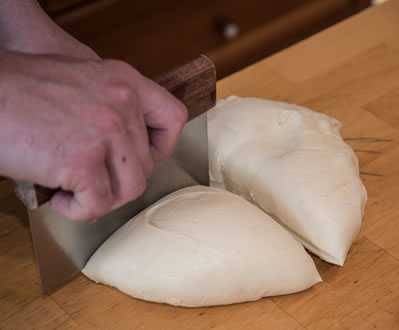Renowned Philadelphia chef Marc Vetri shares his recipe for Naples style pizza dough from his book, Mastering Pizza.
The classic Neapolitan dough is about 60% water by weight. But that’s for pizza baked in a 900°F (482.2°C) oven. When you’re baking at lower temperatures than those in a wood-fired pizza oven, we found that a little more water in the dough helps create a classic Neapolitan crust that’s soft, foldable, and delicately crisp on the bottom.
Makes:
Takes:
Ingredients
Starter
- 2⅔ cups King Arthur bread flour
- 1½ cups water at 45°F (7.2°C)
- .03 ounces fresh yeast (or 0.3 grams active dry yeast, about a scant 1/8 teaspoon)
Dough
- 1½ cups water at 55°F (12.8°C)
- .05 ounces fresh yeast (or 0.6 grams active dry yeast, about generous 1/8 teaspoon)
- 4⅔ cups King Arthur bread flour
- 3½ teaspoons fine sea salt
These recipes were created in US Customary measurements and the conversion to metric is being done by calculations. They should be accurate, but it is possible there could be an error. If you find one, please let us know in the comments at the bottom of the page
Method
- Day 1: Make the starter. Mix everything together in the bowl of an electric mixer, crumbling in the yeast if it’s fresh or sprinkling the dry yeast over the water. Mix just long enough to make sure all the flour is wet. The starter will be wet and sticky. Cover tightly with plastic wrap and let the starter rest at room temperature, about 70°F (21°C) for 24 hours.
- Day 2: Make the dough. By this time, the starter should be bubbly and smell like sex. For the dough, pour the water into a small bowl, crumble in the yeast, and whisk them together until no lumps remain; or, if using dry yeast, you can just sprinkle the yeast over the starter.
- Mix and knead. Add the water (or water/yeast mixture) to the starter and then the flour, and then the salt. Attach the dough hook and mix on low speed for 8 minutes. Switch to medium-low speed and mix for another 4 minutes. The dough should be somewhat loose, since it has a fair amount of water in it. But if you’re mixer is less than 600 watts (600 J/s) and the mixer is straining, remove half of the dough and mix the dough in 2 batches to avoid burning out your mixer motor. Recombine the dough at the end of mixing both batches.
- Ferment. Cover tightly and let the dough ferment in the refrigerator until it proofs, rises, and almost doubles in size, at least 2 hours or up to 24 hours for more flavor. You could also let the dough rise at room temperature for 5 to 6 hours if you’re pressed for time.
- Ball up and ferment again. Lightly flour your hands and a bench knife (the bigger the better). Resist the temptation to dust the dough or your work surface with more flour; that will just make the dough stiffer. You want to keep the dough soft. Use your hand to scrape and dump the mass of dough onto a dry work surface. Use the bench knife to cut and divide the dough into 6 pieces, each about 9.5 oz (270 g). Just cut and scrape away a 9.5-oz (270-g) piece from the dough, transferring the piece to a scale to weigh it (at least weigh the first piece so you can eyeball the rest). The dough will be loose, wet, and sticky—especially if you use some fresh-milled whole grain flour. Handle it with authority. Scoop it up with the bench knife and scrape it off with your fingers. Transfer the 9.5-oz (270-g) piece to a 2-foot-square (61 cm) area on the dry work surface. Then scrape and shape the dough into a ball. To do that, position the bench knife at one edge of the dough and then push the dough in the opposite direction, scraping and pushing the dough at least a foot or two away from you. It will swell up and form an oval shape. Remove the bench knife (using your fingers if necessary), reposition the knife on the pointy end of the dough, and proceed to push the dough in a direction perpendicular to the first, tilting the knife down a bit and scraping the dough with some pressure, swelling up the dough again. Repeat this process of pushing, repositioning, and scraping the dough in opposite directions all around the 2-foot (61 cm) square until the dough goes from a loose oval shape to a more organized round one. It’s almost like shaping a water balloon, so it’s a somewhat delicate operation. You want to gently squeeze all around the balloon to swell it up into a round ball, always increasing the surface tension. When the dough becomes a somewhat organized round ball, use the bench knife to quickly transfer the dough ball to a proofing box or a wide tray with a tight-fitting lid. It will flatten out quite a bit, so leave room for the other dough balls. Repeat the process with each lump of dough, transferring the dough balls to the container and leaving several inches between each—you don’t want the balls reconnecting themselves. I don’t dust them with flour. They get plenty of flour when you shape them. Cover tightly and refrigerate for 24 hours. Or leave at room temperature for up to 12 hours.
- Day 3: Use or chill the dough. After the dough balls have rested, use them immediately or chill them for up to 36 hours after that (until the evening of Day 4). Let the dough rest at room temperature for 1 hour before using to take the chill off. That will make the dough easier to shape.
Nutrition per Serving

This recipe has been adapted with permission from Mastering Pizza by Marc Vetri and David Joachim (Ten Speed Press, 2018).




High quality websites are expensive to run. If you help us, we’ll pay you back bigtime with an ad-free experience and a lot of freebies!
Millions come to AmazingRibs.com every month for high quality tested recipes, tips on technique, science, mythbusting, product reviews, and inspiration. But it is expensive to run a website with more than 2,000 pages and we don’t have a big corporate partner to subsidize us.
Our most important source of sustenance is people who join our Pitmaster Club. But please don’t think of it as a donation. Members get MANY great benefits. We block all third-party ads, we give members free ebooks, magazines, interviews, webinars, more recipes, a monthly sweepstakes with prizes worth up to $2,000, discounts on products, and best of all a community of like-minded cooks free of flame wars. Click below to see all the benefits, take a free 30 day trial, and help keep this site alive.
Post comments and questions below
1) Please try the search box at the top of every page before you ask for help.
2) Try to post your question to the appropriate page.
3) Tell us everything we need to know to help such as the type of cooker and thermometer. Dial thermometers are often off by as much as 50°F so if you are not using a good digital thermometer we probably can’t help you with time and temp questions. Please read this article about thermometers.
4) If you are a member of the Pitmaster Club, your comments login is probably different.
5) Posts with links in them may not appear immediately.
Moderators